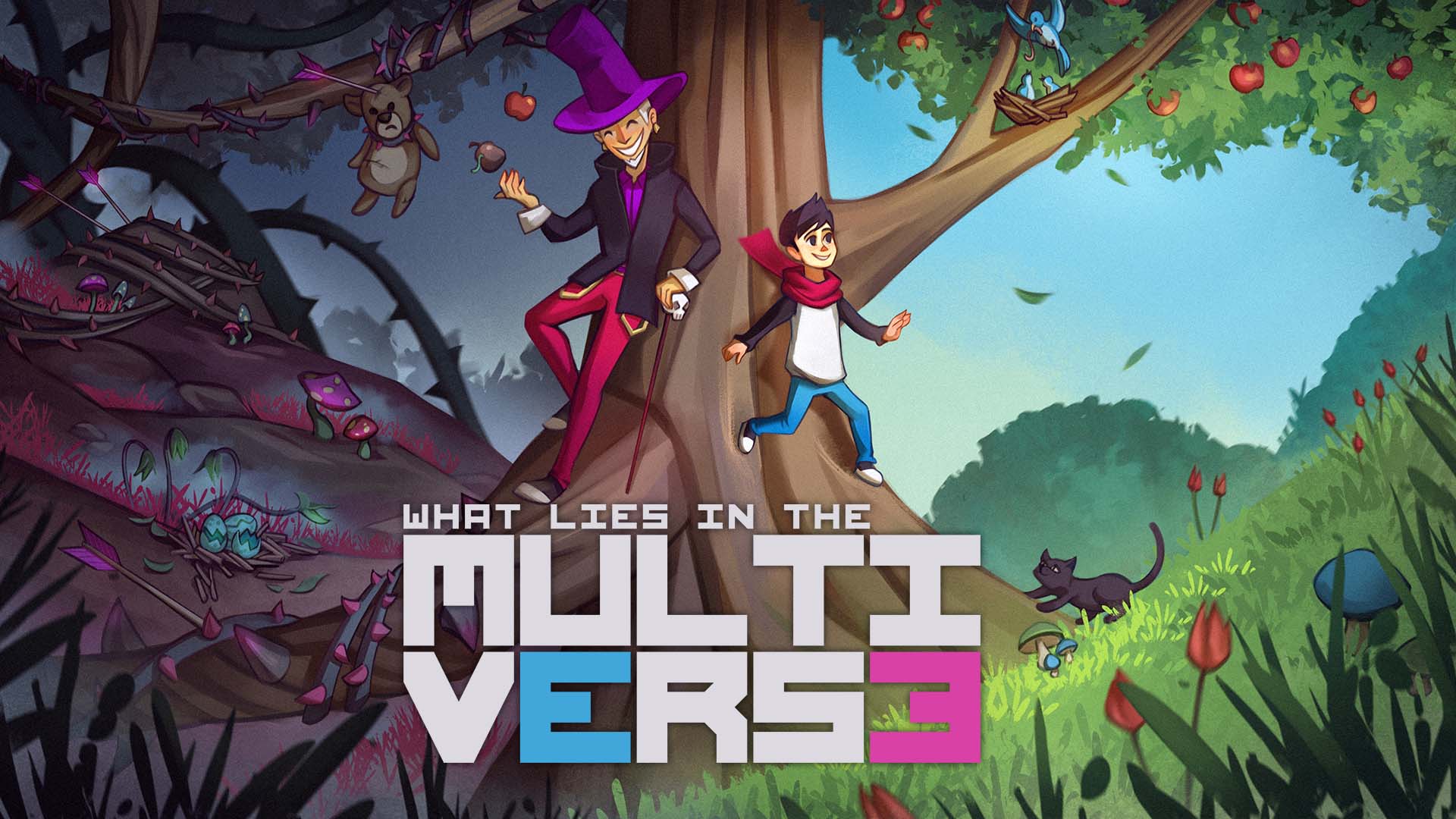A quality 2D platform-puzzler with complex material and tones, What Lies In The Multiverse is another galactic hit for Untold Tales. The Finger Guns review.
I’ve made little secret of my appreciation for the work of Untold Tales and the developers working under their umbrella. Both Aspire: Ina’s Tale and Golf Club Wasteland impressed me tremendously, with the latter even getting my GOTY vote for last year, such was the impact it had on me. As you may have expected then, when What Lies In The Multiverse appeared I jumped at the chance to play it.
And man, what a triumph they’ve achieved again.
A trailer or description of Multiverse probably doesn’t quite do the justice this thoroughly brilliant little game deserves. Exploring some complex themes, delivering witty jokes with charming effect and offering a surprisingly thought-provoking yet approachable set of puzzles to put your grey matter to, Multiverse is another perfectly tuned string to Untold Tales’ increasingly impressive bow.
String Theory, But Even More Puzzling
As you likely will have gleaned from the title, Multiverse is all about… well, the multiverse. Opening in your shockingly tidy room, our affectionately named hero Kid is hard at work exploring the limits of endless possible universes. After having some amusing banter with his feline pet, we’re sucked into an alternate universe, where things start to become… extra terrestrially intriguing.
You’re rescued from your bumbling interfering with the endless expanse by a sharply dressed chap named Everett. Donning a comically oversized purple top hat and armed with a mouth of witty banter, there’s a certain level of scepticism about his intentions and genuine affinity for little ol’ Kid. He’s endearing yet suspicious in equal measure, making the pair’s alliance to find Everett’s companion Ez all the more enthralling.
In fact, the entire cast of characters, including the primary antagonist group who are hot on the heels of our dear shady friend (therefore us too) are brilliantly fleshed out. Lise’s earnest yet painfully doubt ridden psyche brings empathy, Barres’ flamboyant annoyance is engaging, Leo’s cold exterior mixed with underlying emotion and even Nash’s petulant but flagrant determination all bring a layer of depth to every character you’ll meet. They’re a rag-tag group but you’ll get to know each of them pretty well come the end, and I found myself a little surprised at just how invested I was in their journeys.
It helps that Multiverse’s writing is absolutely on point. Whether it be delivering cutting sarcasm or playing off of video game tropes in general, the writers completely nail the text dialogue throughout. There are so many moments I want to mention but won’t so as to not spoil the surprises for you, but having a burly looking brute respond with “HATE” and “REVENGE” before deep-diving into the philosophical underpinnings of their favourite book with Everett gingerly replying with a nonchalant acknowledgement was a particular highlight.
You’ll experience a number of singular moments in the roughly 6-hour journey that’ll make you laugh, think, toil and reflect in equal measure, which is the sign of a confident and well-written story. The ending hits some strong emotional notes, tackling themes of grief and loss, as well as people’s sense of autonomy within a universe designed to make us feel insignificant. Come the credits, I couldn’t help but be impressed with both the characters and the overall narrative. It’s well worth experiencing.
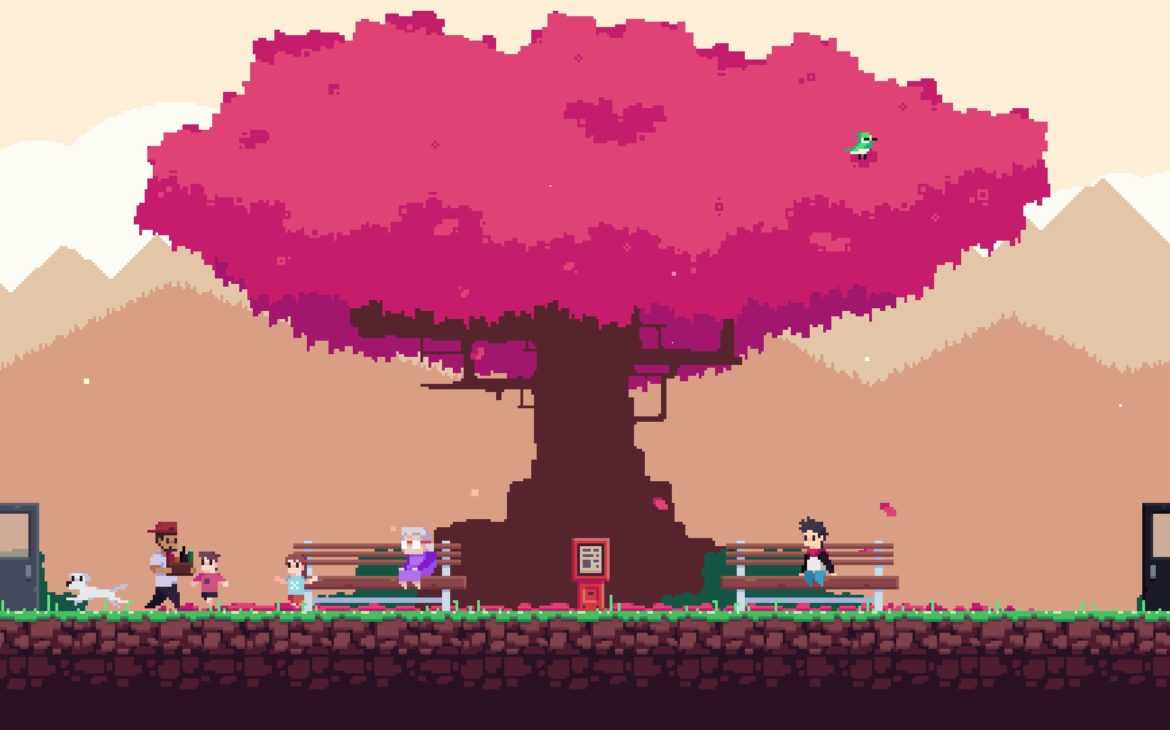
Schrodinger’s Boxes
Untold Tales seem to be fond of the 2D platforming genre. Aspire was almost identical in design to Multiverse, but this newest release offers a bit more in the shape of challenge and complexity. The vast majority of your time will be spent moving from one area to the next on your pixelated 2D maps. Usually (as in, always) they’ll be a variety of obstacles blocking your path. Fortunately, the universe holds all solutions, usually of the dangerous variety.
See, Everett, our trusty companion, has a tool called a Voyager which allows him (and by extension, us) to transcend time and space to overcome any pesky blockage to progress. Chapters will tinker with what your shifting universes will do. In some, you’ll only be able to interact with your current universe, meaning you’ll be finding keys to open doors, moving boxes, hitting switches, rearranging objects to reach higher or lower areas. The usual stuff.
However, once you start using alternate dimensions, you’ll be having to mess around with all sorts of other elements. The alternate dimension may have everything consumed by ice, providing fatal pitfalls easy to skate off, but also making shifting boxes and longer jumps a breeze. Later on you’ll be able to climb vines, but the air will become poisonous, placing a very short, limited window to make progress. Eventually, you’ll even hit inverted gravity, where yourself and virtually every other loose object now flows upwards.
Each chapter will introduce you to the new mechanic before slowly ramping up the challenge of utilising it to succeed. Most puzzles are fairly straightforward and can be completed pretty rapidly, with some occasional late-stage chapter challenges requiring a bit more mastery to overcome them. Unlike Ina’s Tale, there were a handful that actually had me stumped for longer than I’d like to admit, requiring me to consider my actions and plot out my moves. While I had some moments of frustration, this was only due to my own impatience or occasionally just straight up being stupid. One area in particular wasn’t even a puzzle, I just hadn’t seen a certain block could be moved… my brains atoms must have been in another multiverse.
In the later sections you’ll be required to put everything you’ve learnt to use, sometimes all in short sequence. It gives off a sense of having learnt the game while also rewarding you for using your brain, but without becoming horrendously tedious. With only blocks, switches, boxes and occasional cosmic anomalies to keep the gameplay fresh, I had feared it would become boring, but this never actually came to pass. As puzzler-platformers go, this is firmly in the easy-moderate category, with the occasional headscratcher thrown in for good measure.
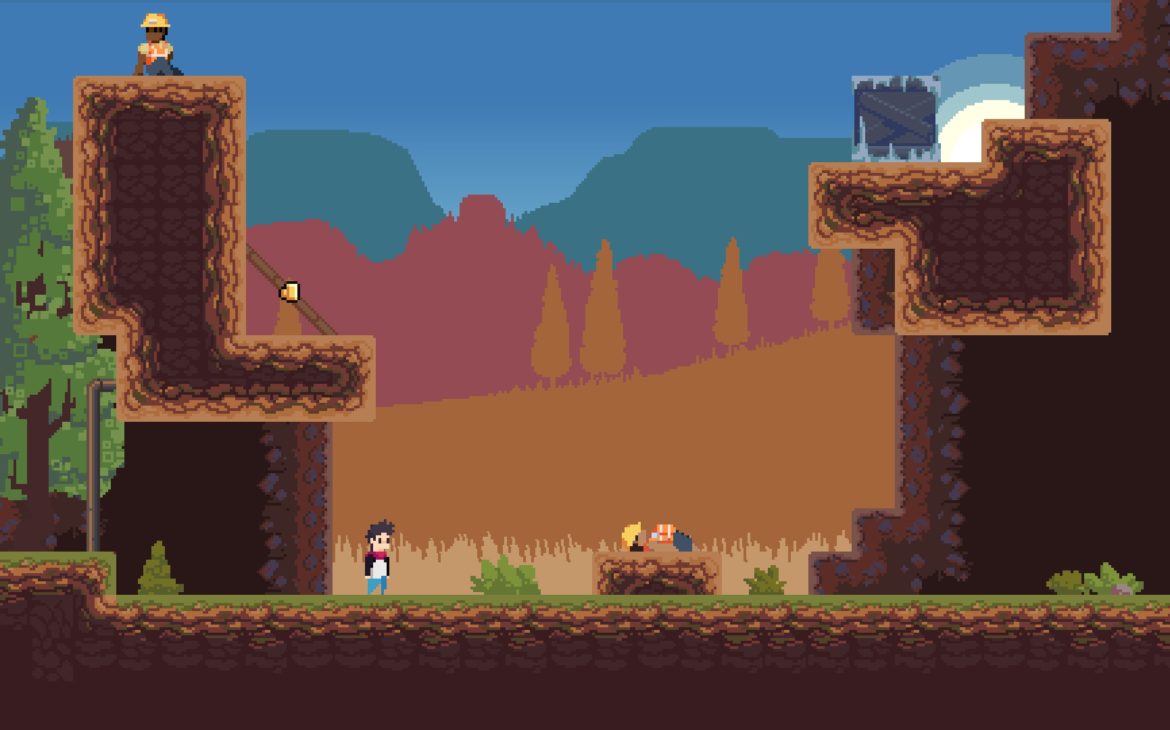
Wormhole To Another Universe’s Secrets
Kid is an inquisitive little fellow, so on your travels you’ll get the opportunity to search out hidden areas for collectible notes, items, keepsakes and other trinkets. There are clever little interactions you can have with NPCs in certain areas too. Sitting next to an old lady as she ambles on about her old flame, or bugging a character enough times with conversation prompts they label you King Douchebag. Charming.
These interactions reward you for exploring and engaging with the world Kid’s currently invading with his presence. It ain’t all cosmic surfing and Red Dwarf sunshine though. What Lies In The Multiverse also had some truly dark material you can unearth in these hidden areas. Treversing the “regular” universe shows NPCs living life and usually in harmony. Switch to the more sinister alternative universes though, and well… things get bleak.
You may think it amusing that another innocent kid is idly fishing in a below-ground cave which has no fish in it, only to then see that when the Calamity struck in the other universe, they drowned as the cave filled with water and they had no escape route. You’re never told anything explicitly, but you’ll notice a corpse, or a note depicting their final moments, or later you’ll come across their loved one in the normal universe searching for them, oblivious to the fate you know is coming.
My above example is probably one of the most tame. Some little side stories hidden away have cannibalism (which is particularly heart-wrenching when you see the happiness of the normal universe), murder, yearning for loved ones who were never seen again. In honestly, these little tales had more genuinely emotive moments than some fully-fleshed out AAA releases manage in 20+ hours. The little sprites of pixelated character models helpfully define them as specific beings, while the writing and dialogue of the normal realm juxtaposed against the grim reality of bones and lifelessness as you switch universes in an instant really hits home the impact.
Long story short, exploration and experimenting by dipping in-and-out of the alternative universe will pay dividends for those with a curious mind. They were my favourite (and most heartbreaking) moments that’ll stick with me long after I’ve finished playing.
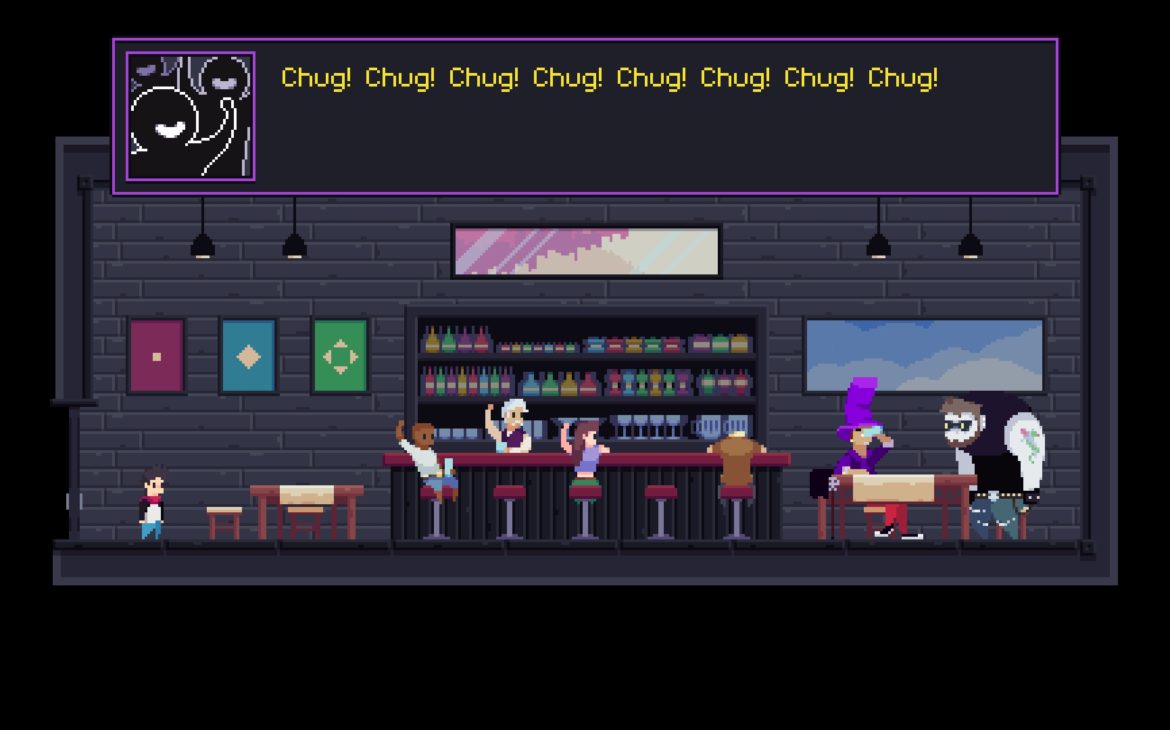
Universal Pixel Art
I’m going to be straight up here, I’m not normally a fan of retro 2D graphic styles in most games. I’m not a graphics fanatic or anything, but the pixelated look has never particularly appealed to me after we reached the PS3/360 era. On this front however, What Lies In The Multiverse has made me something of a believer.
I mentioned before about the clearly defined character models which utilise some intelligent design and colour to differentiate almost every soul that exists across the dimensions. Barett exudes confidence and wit from his attire, Leo’s trenchcoat eminates her aura of coldness. A bartender parading a moustache fit for the greatest of machismos. The people of this 2D world look and animate distinctly and with gusto, helping to elevate the themes and stories going on around them.
Each chapter also delivers an entirely new environment, immaculately designed and crafted to lure you into the world. One moment you’ll be journeying across a barren desert, before climbing through an overgrown jungle complete with running stream, then fumbling through a sterile research facility. This is to say nothing of the sinister, dark and gloomy alternate universes you’ll have to endure.
Poison exudes a deep purple, foilage being suffocated and decaying. Bodies become piles of bones and skulls, ice encapsulates buildings and objects, monuments become decrepit and broken. It’s pretty intimidating, but in a well-crafted and discomforting way. These alternate universes are visually standout in their own grim way, again feeding into the over-arching feeling of despair from the narratives and people whom once inhabited these worlds before their untimely fates.
What Lies In The Multiverse looks awesome, is the long and short of it. Even for someone who doesn’t typically appreciate this art style as much as others, I couldn’t help but have fun taking it all in and appreciating how it so beautifully coalesces with the rest of the game’s ideas.
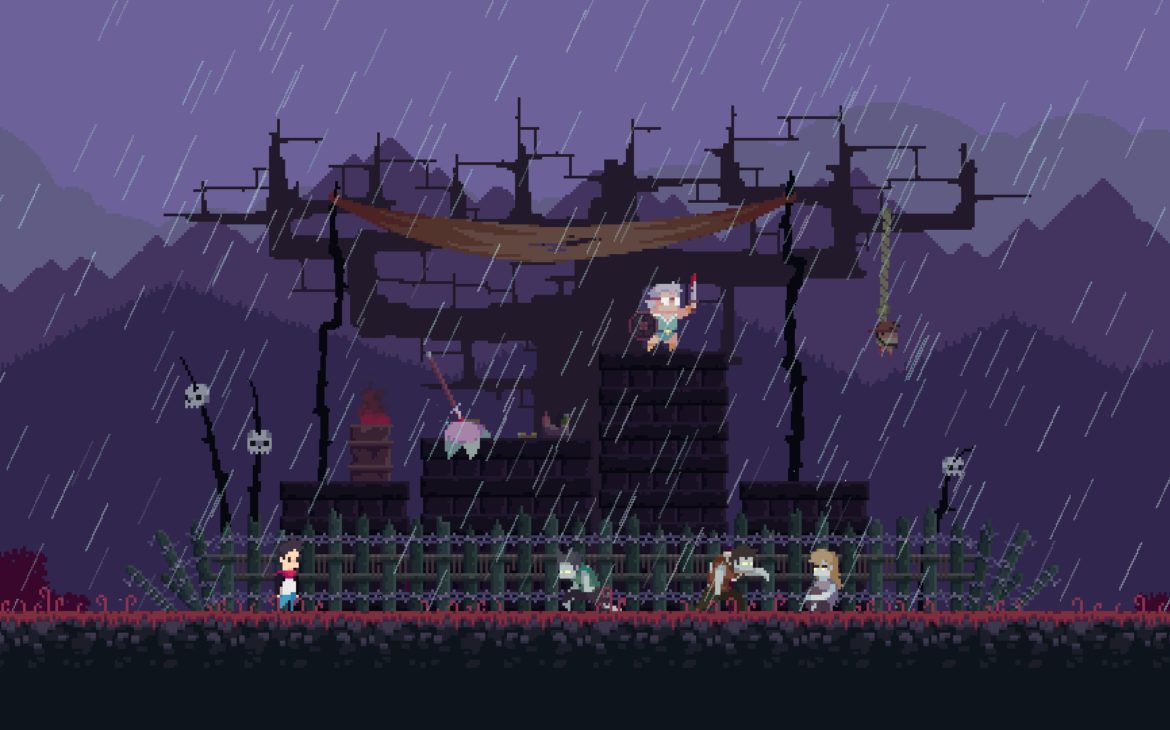
Multiverse Of Greatness
I’ve been universally positive in my writing up to this point and to be honest, I think that’s a great indication of just how fun this was to play. There were some nitpicks – the control input can be slightly delayed, I died from clipping between a box and the floor once, a couple of puzzles involved a little too much waiting around etc. However, these were exactly as described – nitpicks.
What Lies In The Multiverse isn’t a perfect game and it still may be a little too easy for more veteran players, but it has such an absorbing narrative, combined with brilliant writing, a lovely (and hellish) art-style, mixed with some truly dark yet emotion-inducing discoveries for you to uncover. It’s one of those games that’s worth playing to experience the findings individually and to see if it hits the same notes for yourself as it certainly did for me.
Clocking in at about 6 hours, it’s also double the length of both Aspire and Golf Club Wasteland. With a wealth of collectibles to discover and even an alternate ending to seek out, there’s a lot here to justify diving in.
Studio Voyager & IguanaBee have knocked a great game into our dimension and you’d be remiss to not try another Untold Tales wonder.
A wonderfully written story, combined with some dark, depressing and ultimately great side discoveries and accessible yet engaging platform-puzzling prove to be another fantastic addition to Untold Tales’ portfolio. It may not be perfect, but we can rejoice that What Lies In The Multiverse exists within our dimension to experience.

What Lies In The Multiverse is launching on Xbox One (review version), PS4, Nintendo Switch and PC via Steam on March 4th, 2022.
Developer: IguanaBee / Studio Voyager
Publisher: Untold Tales
Disclaimer: In order to complete this review, we were provided with a promotional copy of the game. For our full review policy, please go here.
If you enjoyed this article or any more of our content, please consider our Patreon.
Make sure to follow Finger Guns on our social channels –Twitter, Facebook, Twitch, Spotify or Apple Podcasts – to keep up to date on our news, reviews and features.
